 Jonathan Janson
Jonathan Janson
Questions of Authenticity: What Science Can’t Tell UsLecture: International Vermeer Symposium, Rijksmuseum Amsterdam, March 29, 2023
 slide 1
slide 1(slide 1) Good afternoon, it's both a privilege and pleasure to speak with you here at the Rijksmuseum.
Since I’ll be talking quite a bit about the Young Woman Seated at a Virginal in the New York Leiden Collection, I’ll be referring to it as either the "Leiden picture" or the "Leiden painting" to avoid confusing it with a work by Vermeer in the London National Gallery…with a similar theme and title, A Lady Seated at a Virginal.
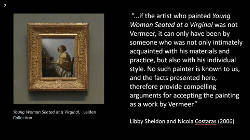 slide 2
slide 2(slide 2) After a 10-year scientific investigation of the Young Woman Seated at a Virginal, Libby Sheldon and Nicola Costaras published a report in 2006 in which they conclude: "if the artist who painted the Young Woman Seated at a Virginal was not Vermeer, it can only have been by someone who was not only intimately acquainted with his materials and practice, but also with his individual style. No such painter is known to us, and the facts presented here, therefore provide compelling arguments for accepting the painting as a work by Vermeer."
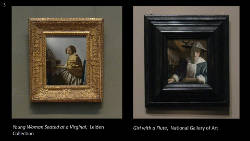 slide 3
slide 3(slide 3) Sixteen years later, the Washington National Gallery of Art, proclaimed the Girl with a Flute is not by Vermeer, but by an unidentified follower, based on a two-year scientific and stylistic investigation of the four paintings in their collection traditionally attributed to Vermeer. In the case of the Leiden work, authenticity was dependent on the assumption that there existed no followers of Vermeer. Instead, the National Gallery concluded that the scientific evidence could be explained only by assuming the existence of a follower. So, in both cases, it’s not a matter of believing or not believing the scientific evidence, but believing or not believing the interpretation of the scientific evidence. It won’t be lost on anyone in this auditorium that with the same scientific data, the National Gallery of Art maintains the Girl with a Flute is not by Vermeer, while the Rijksmuseum maintains that it is by Vermeer. So we have a painting that is or is not a Vermeer, depending on which museum it’s exhibited in.
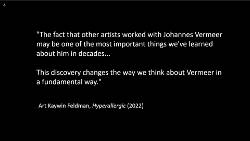 slide 4
slide 4(slide 4) And let’s remember that the National Gallery didn't advance just an art historical hypothesis; they established an art historical fact. The National Gallery’s art director confidently stated: "The fact that other artists worked with Johannes Vermeer may be one of the most important things we've learned about him in decades"... "this discovery changes the way we think about Vermeer in a fundamental way."
So now such a prestigious institution has unleashed a follower, why couldn’t he have painted the Leiden picture too? The most promising venue for answering this question is an exhaustive analysis of the painting’s front side, which has been largely neglected.
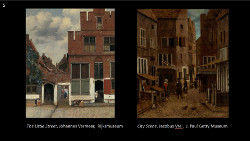 slide 5
slide 5(slide 5) However, as a painter, I must tell you that authorship is a secondary question. If someone proved scientifically the Little Street was by Van Meegeren, it wouldn’t diminish my admiration for the picture, likewise if someone proved scientifically this Jacobus Vrel was painted by Vermeer, it wouldn’t increase my admiration, but only my curiosity. The same goes for the Leiden picture or the Girl with a Flute.
Composition
Since I’ll be making comparisons with the London Lady Seated, it’s important to remember that even though the Leiden picture is much smaller, the figures and instruments of the two works are almost the same size.
The composition is exceptionally simple, a nude wall, a virginal with a music stand and a young woman seated on a blue chair. (slide 6) The motif of the lady seated at a virginal is plucked directly from the heart of the London Lady Seated. (slide 7) The body and arms are positioned much in the same way, and so is the turned head and outward gaze.
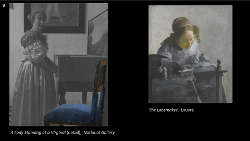 slide 8
slide 8(slide 8) The blue chair is a present in the lower right of Lady Standing at a Virginal, in London. The hairdo and empty-wall are quotes from the Lacemaker.
The process recalls the term "copy and paste," because the only element of any consequence that never appears in any other work by Vermeer is the yellow shawl, which, paradoxically, is also the most contentious part of the picture.
The Shawl
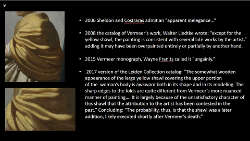 slide 9
slide 9(slide 9) Sheldon and Costraras themselves admit an "apparent inelegance," suggesting that its lackluster appearance may be due to lost glazes or overpainting by another hand.
In his complete catalog of Vermeer’s work, Walter Liedtke wrote: "except for the yellow shawl, the painting is consistent with several late works by the artist," adding it may have been overpainted entirely or partially by another hand.
In his Vermeer monograph, Wayne Franits called the shawl "ungainly."
In the 2017-version of the Leiden Collection catalog, the question of the shawl is elaborated more extensively:
The somewhat wooden appearance of the large yellow shawl covering the upper portion of the woman’s body is awkward both in its shape and in its modeling. The sharp edges of the folds are quite different from Vermeer’s more nuanced manner of painting…. It is largely because of the unsatisfactory character of this shawl that the attribution to the artist has been contested in the past." Concluding: "The probability, thus, is that the shawl was a later addition, likely executed shortly after Vermeer’s death.
However, a recent investigation at the Rijksmuseum has discovered that the shawl is by the same hand as the rest of the picture. Obviously, science can prove the hand that painted the shawl is the same one that painted the rest of the painting, but it can’t prove which artist it belonged to.
Underneath the Shawl
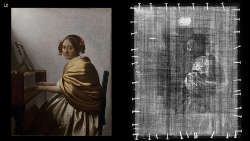 slide 11
slide 11 (silde 10) Sheldon and Costaras also suggested there was another garment under the one we see today. An x-ray image reveals an accumulation of loose brushstrokes, which have been understood in various manners. They see a "more intricately designed sleeve" and a lower neck-line, which perhaps suggests a short "bordered cape." Liedtke, instead, suggested it was a jacket similar to the one we see in Vermeer’s Guitar Player.
The latest revision of the Leiden Collection catalog (March, 2023) claims Vermeer probably painted the yellow shawl on top of the fur-trimmed jacket to update the woman’s clothing so that it would be "compatible with the more flowing style of dress fashionable in the mid-1670s. Ermine-bordered yellow jackets, such as the one seen in The Guitar Player, went out of favor after 1672…"
So again, we see how identical scientific evidence can lead to different conclusions.
(slide 11) In any case, a virtual reconstruction shows the type of jacket seen in the Guitar Player or the Mistress and Maid would have extended almost to the bottom of the Leiden picture. To fit completely under the shawl, it would have to be about this small! (slide 12)
I wonder if there’s any scientific evidence of such a large and complicated garment, especially considering the Leiden catalog maintains it was "fully realized"?
The face
(slide 13) What to say about the lady’s head? The face and forehead are Byzantine flat, and the play of light and shadow is unusually harsh. The shadows are muddy brown, devoid of transparency, giving the head an unusual sculptural quality, alien to Vermeer’s empathetic treatment of flesh. The thick streak of light paint running down the nose makes it stick out ungracefully from the face. The shadow below the nose is so dark it almost looks like a mustache. (slide 14) The lips look like a clumsy attempt to mime those of the London piece, minus, however, Vermeer's trademark pointillé highlight.
(slide 15) Instead, the London head is modeled with exceptional delicacy. The shadowed side of the nose blends imperceptibly into the illuminated cheek to its left, exactly in Study of a Young Woman and Girl with a Pearl Earring. They are there enough, but seem sculpted by light rather than sticky paint.
(slide 16) The refined modeling of the eye sockets and cheeks is utterly foreign to the Leiden head.
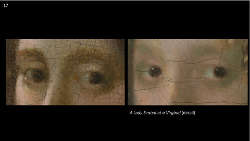 slide 17
slide 17(slide 17) The irises of the Leiden eyes have slightly different shapes and lack those all-important 11 o'clock highlights which have accompanied paintings of eyes for centuries. On the other hand, the irises of the London piece are perfectly circular and subtly blurred around the edges. Each one with a crisp microscopic highlight. Details like these underlines Vermeer’s truly extraordinary level of technical skill, because each iris is no larger than a match head.
So, if the painter of the Leiden piece possessed the same level of skill that’s so starkly evident in the London Lady Seated, why did he fail to use it?
The Hair
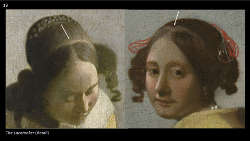 slide 18
slide 18(slide 18) Experts generally believe the hairdo is the same as the Lacemaker’s.
But, while the two parts of the Lacemaker’s hair expose the delicate flesh of the figure’s head, the parts of the Leiden hair are painted with a muddled gray, imprecisely modeled with a bit of white paint. You can’t see the pink flesh or feel the tension of the pulled-back hair, which are achieved with uncanny economy in The Lacemaker.
Here’s another problem: the "2"-shaped curl which dangles to the left of the lady’s cheek. It’s almost identical to the curl of The Lacemaker. But how could that be? Could the hair of two different women produce the exact same curl? Now, why on earth would such a creative painter as Vermeer ever quoted himself so literally?
Pearls
(slide 19) Most critics believe the two irregular dabs of white paint were meant to represent pearls, presumably, of a necklace. But there’s really no necklace at all. There are no pearls to the left or the right, and neither one has a highlight, and remember, to make a pearl look like a pearl it has to have a highlight, not just a round body (otherwise it just looks like a round spot of light gray paint).
And what’s holding them in place? Are they balancing on the upper edge of the lady’s shawl or just mysteriously floating in space? (There are no such conceptual incoherencies in Vermeer ‘s works).
(slide 20) Please compare the rudimental Leiden "necklace" to the necklaces in Vermeer’s works of the same period, which, trust me, are tiny masterpieces of pictorial synthesis (technically speaking, completely off the charts).
VIRGINAL
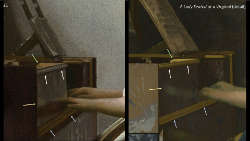 slide 21
slide 21 (slide 21) The virginal also presents anomalies. The modeling of the decorative molding of the London piece is crisp and clean. Instead, the same elements in the Leiden virginal are sloppily defined, discolored or misaligned. The music book looks more like a slab of gray stone, rather than a paper foglio.
The reflection of the lady’s arms on the front side of the virginal is significantly less subtle than what we see in the London Lady Seated, despite the fact it’s often been marshaled as proof of the painting’s authenticity.
In any case, whether you think it’s painted better or worse, it remains yet another unthinking, copy-and-paste.
(slide 22) But perhaps the most serious inconsistency is the fall of light on the virginal. At first glance, the virginal would seem to be blocking the light falling down from the upper left corner of the picture, casting a clean diagonal shadow on the gown. similar shadows are seen in Vermeer’s Lady Writing and Mistress in Maid. However, in both cases, the tops of the tables are illuminated, as they should be. (slide 23) But the top of the virginal and music stand in the Leiden picture are not.
Satin Gown
The satin gown is generally considered the most refined passage of the painting. (slide 24) However, the deep folds are rendered with anonymous dark browns, making them appear as mute, empty voids rather than light-filled recesses. This is not the way satin is painted. The key to capturing the typical reflectivity of satin is to avoid too much contrast between the illuminated mountains and the shadowed valleys of the folds. (slide 25) This technique is clearly visible in the gown of Vermeer’s Guitar Player (and all similar gowns in Vermeer’s works.
(slide 26) Please note how music-stand, the double shadow behind it, the dimly lit virginal and the shadow cast of the gown create a large dark compositional mass that divides the musician from her instrument, as if the two had nothing to say to each other (slide 27) One last thing, if you follow the upper profile of the Leiden gown, it rises almost to the figure’s chest, Empire style. Real legs certainly don't do that and they don’t in the London piece work either, despite the fact that the two figures are seated in the exact same position.
Conclusion
Let’s examine the painting in context.
Despite various attempts to tie the Leiden piece to Vermeer’s later works, the painting’s bareness and lack of novelty are at odds with what we see in Vermeer’s later works.
Imagine setting up the Leiden composition in your studio. You set up a virginal and chair parallel to a blank wall in the corner of the room and then instruct the model to sit down, place her hands on the keyboard and look out towards the viewer. And then you start painting.
Is it possible Vermeer would have been interested in such an unchallenging program?
There is, in fact, no evolution toward Bauhaus less-is-more, or even a particularly restrained simplification. On the contrary, Vermeer’s later works exhibit particularly sophisticated compositional designs, numerous new props and passages of exceptionally daring brushwork.
(slide 28) Take, for example, The Guitar Player often summoned to ratify the Leiden picture’s simplicity and lack of novelty. It’s the first and only time that a guitar appears in Vermeer’s work. The figure is unusually large. Instead of hiding behind some foreground object as we see in Vermeer’s early and mature works, she faces the spectator directly, positioned dangerously off-center to the left. She looks away from the light which, unconventionally, comes from the right. The left-hand arm chopped off by the edge of the canvas offers yet another example of a high-risk compositional gamble.
(slide 29) Note the audacious brushwork of the gilt sound hole, the blurred strings that suggest they have been strummed a moment ago.
(slide 30) And note too how the bizarre highlights of the gilt frame peek through the dangling curls here and there. (All these details show an ingenious painter, in full control of his means with discrete number tricks still up his sleeve).
So here’s my point of view…All we see in the Leiden composition is a modest collection of timidly re-elaborated motifs, each one much more skillfully painted in the original work from which they derives.
(slide 31) As I've already pointed out, the only element that somehow distinguishes the Leiden piece from any of Vermeer’s 36-odd paintings is the yellow wrap.
Is that enough to claim the picture is by Vermeer, one of the most creative and skilled painting technicians of all time?
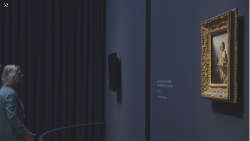 slide 32
slide 32(slide 32) Science can tell which materials and which methods are compatible or not with those of a given artist, but for the moment it still can’t guarantee the authenticity of a work of art or if it’s highly creative or is simply aped, exceptional or blandly ordinary.
Thank you very much.



















